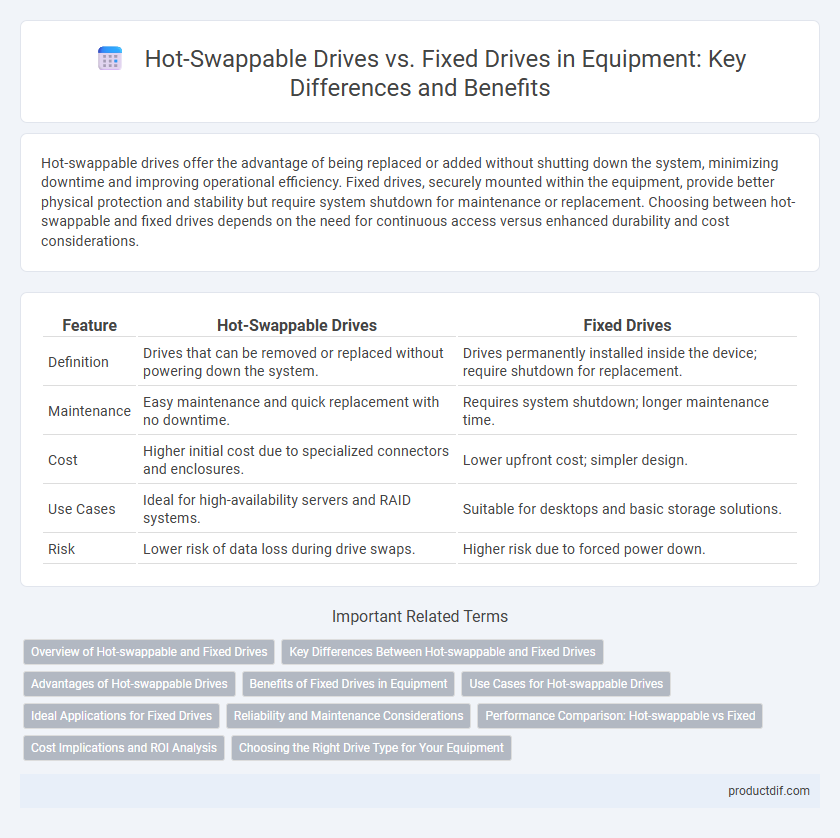Hot-swappable drives offer the advantage of being replaced or added without shutting down the system, minimizing downtime and improving operational efficiency. Fixed drives, securely mounted within the equipment, provide better physical protection and stability but require system shutdown for maintenance or replacement. Choosing between hot-swappable and fixed drives depends on the need for continuous access versus enhanced durability and cost considerations.
Table of Comparison
| Feature | Hot-Swappable Drives | Fixed Drives |
|---|---|---|
| Definition | Drives that can be removed or replaced without powering down the system. | Drives permanently installed inside the device; require shutdown for replacement. |
| Maintenance | Easy maintenance and quick replacement with no downtime. | Requires system shutdown; longer maintenance time. |
| Cost | Higher initial cost due to specialized connectors and enclosures. | Lower upfront cost; simpler design. |
| Use Cases | Ideal for high-availability servers and RAID systems. | Suitable for desktops and basic storage solutions. |
| Risk | Lower risk of data loss during drive swaps. | Higher risk due to forced power down. |
Overview of Hot-swappable and Fixed Drives
Hot-swappable drives enable users to remove and replace storage devices without shutting down the system, enhancing uptime and flexibility in data management. Fixed drives are permanently installed within a system, providing stable and consistent performance but requiring system downtime for maintenance or replacement. Choosing between hot-swappable and fixed drives depends on the need for operational continuity and ease of hardware upgrades.
Key Differences Between Hot-swappable and Fixed Drives
Hot-swappable drives allow users to remove or replace drives without powering down the system, enabling continuous operation and minimizing downtime. Fixed drives require the system to be powered off before installation or removal, which can interrupt workflow and increase maintenance time. Hot-swappable drives are commonly used in enterprise storage environments where uptime and quick drive replacement are critical, whereas fixed drives are typically found in desktop or consumer hardware where cost and simplicity are prioritized.
Advantages of Hot-swappable Drives
Hot-swappable drives enable seamless replacement or addition of storage without powering down the system, significantly reducing downtime in critical environments. Their design supports continuous operation and maintenance, enhancing system reliability and uptime. This flexibility is essential for data centers and enterprise storage solutions requiring high availability and efficient hardware management.
Benefits of Fixed Drives in Equipment
Fixed drives offer enhanced durability and stability in equipment due to their secure mounting, reducing the risk of data loss from physical movement or vibrations. Their consistent connection ensures reliable performance and faster data access speeds, essential for high-demand applications. Cost efficiency and simplified maintenance make fixed drives a preferred choice for long-term storage solutions in industrial and enterprise environments.
Use Cases for Hot-swappable Drives
Hot-swappable drives excel in environments requiring continuous system availability, such as data centers and enterprise servers, where drives can be replaced without shutting down the system, minimizing downtime. These drives are ideal for RAID configurations and network-attached storage (NAS) devices, enabling efficient maintenance and scalability. Their use in mission-critical applications ensures data integrity and operational continuity while facilitating hardware upgrades and failures management.
Ideal Applications for Fixed Drives
Fixed drives are ideal for environments requiring high-capacity storage with consistent performance, such as desktop computers, gaming consoles, and servers where drive swapping is infrequent. These drives offer enhanced durability and stability, making them suitable for long-term data retention and continuous operation. Fixed drives also provide cost-effective storage solutions when hot-swappable functionality is unnecessary.
Reliability and Maintenance Considerations
Hot-swappable drives enhance reliability by allowing seamless replacement without system downtime, reducing the risk of data loss during maintenance. Fixed drives, while generally more secure in physical placement, require complete system shutdown for servicing, increasing maintenance time and potential disruption. Choosing hot-swappable drives improves uptime and simplifies drive management in critical environments.
Performance Comparison: Hot-swappable vs Fixed
Hot-swappable drives enable seamless drive replacement without system downtime, maintaining continuous performance during hardware upgrades or failures. Fixed drives often provide slightly higher sustained data transfer rates due to direct connections but require system shutdown for maintenance, impacting availability. In high-availability environments, the performance trade-off favors hot-swappable drives for minimizing operational disruptions while delivering comparable throughput.
Cost Implications and ROI Analysis
Hot-swappable drives typically entail higher upfront costs due to advanced connectors and enclosures but offer significant savings by minimizing downtime and maintenance labor costs, enhancing overall ROI. Fixed drives have lower initial expenses but can lead to increased operational costs from system interruptions during drive replacements, potentially reducing long-term ROI. Evaluating total cost of ownership with emphasis on maintenance frequency and system uptime is crucial for accurate ROI analysis between hot-swappable and fixed drives.
Choosing the Right Drive Type for Your Equipment
Hot-swappable drives enable seamless replacement or upgrades without powering down equipment, significantly reducing downtime in critical environments. Fixed drives, often integrated directly into the hardware, typically offer enhanced structural stability and may provide better performance for consistent workloads. Selecting the ideal drive type depends on factors such as operational continuity needs, maintenance flexibility, and performance requirements specific to your equipment setup.
Hot-swappable drives vs Fixed drives Infographic

 productdif.com
productdif.com